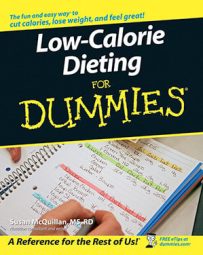One way to keep track of how much food you’re eating is to focus on portion sizes, rather than on individual calorie counts. Here’s a quick-reference guide to standard portion sizes of different foods within each food group that provide approximately the same number of calories. Keep in mind that these guidelines are general; calories actually vary within each food group, depending not only on the food itself, but also how it’s prepared.
Vegetables
One serving from this group, in the amount show, provides about 25 to 45 calories.
1 cup spinach, lettuce, kale, collards, or other raw leafy green or uncut vegetables such as green beans, mini carrots, or snow peas
1/2 cup any other nonstarchy vegetables (see below), cooked or finely chopped raw
1/2 to 3/4 cup vegetable juice
Fruit
One serving from this group, in the amount shown, provides about 60 to 80 calories.
1 small to medium apple, banana, orange, peach, or other whole fruit
1/2 grapefruit or mango
1/2 cup chopped fruit
15 grapes or 12 cherries
7 dried apricot halves, 3 prunes, or 2 tablespoons raisins
1/2 cup fruit juice
Grains and starchy vegetables
One serving from this group, in the amount shown, provides about 80 calories.
1 slice bread
1 small (6-inch) tortilla
1/2 English muffin
1/2 small bagel
1/2 small (6-inch) pita
1/2 cup hot cereal
1/2 to 3/4 cup cold cereal (11/2 cups puffed cereal with no milk)
1/2 cup cooked pasta or rice
1/2 cup starchy vegetables such as peas, carrots, beans, corn, or potatoes (of any kind).
Proteins
One serving, in the amount shown, provides between 150 to 250 calories.
3 ounces cooked lean meat, poultry, or fish
1 cup cooked dry beans, lentils, or split peas
1 to 11/2 cups (2 to 3 ounces) tofu cubes
2 to 3 eggs
2 tablespoons peanut butter
Milk and dairy products
One serving, in the amount listed, provides 150 to 200 calories. Lower-fat and fat-free dairy products often contain fewer calories. For instance, whole milk contains about 150 calories per cup while 2 percent lowfat milk contains 120 calories per cup, and skim milk contains only 90 calories per cup. When considering flavored yogurts and other dairy products, however, be sure to check the nutrition labels for actual calorie counts because lower fat doesn’t always mean fewer calories.
1 cup whole milk or yogurt
1 1/2 ounces cheese such as cheddar, muenster, brie, blue, Swiss, mozzarella
1/2 cup ricotta cheese
1/3 cup grated Parmesan or Romano
2 ounces American cheese
Fats
One serving, in the amount listed, provides about 35 to 40 calories. Reduced-fat spreads often contain fewer calories.
1 teaspoon butter, margarine, regular salad dressing, regular mayonnaise, or vegetable oil

